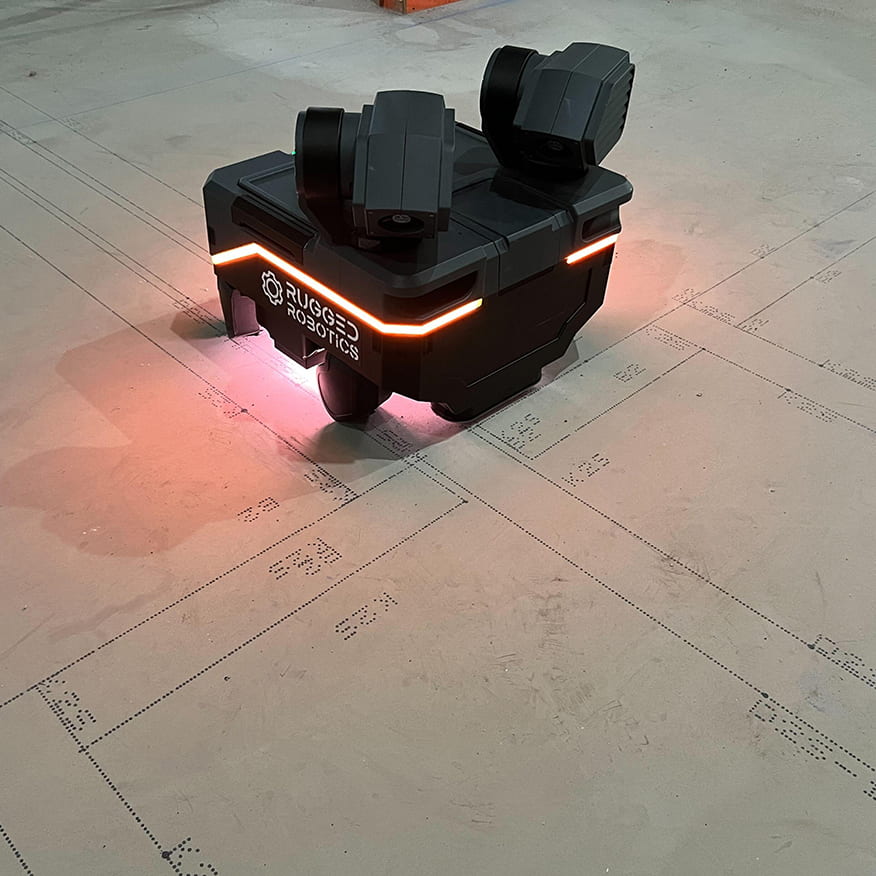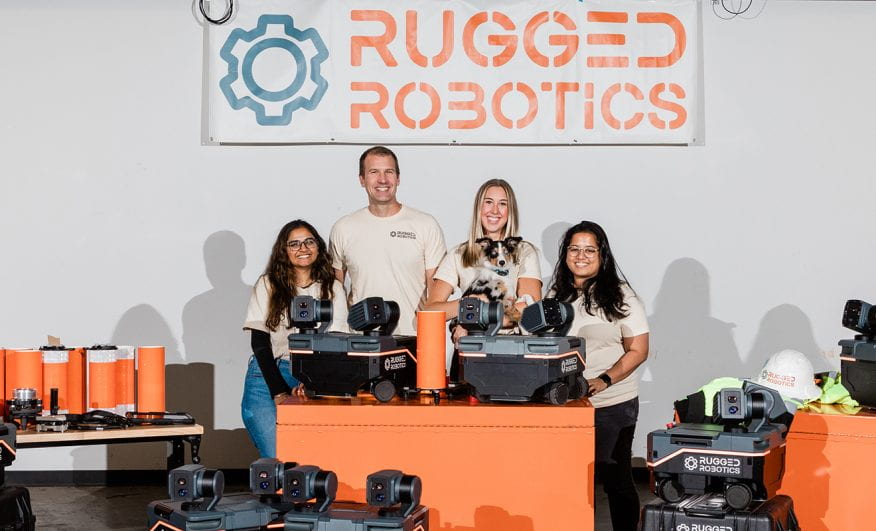Aiming High
Pioneering fighter pilot Stacey Cotton Bonasso '90 inspires the next generation as a high school STEM teacher.
Read StoryRobots tackle the back-breaking, detailed work of layout transfer.
To Derrick Morse ’01, MS ’03, gray spray paint on the floor of a building under construction is a sign of an industry problem—one ripe for a robotic solution. The paint represents a mistake made when workers hand-transfer engineering plans from an architect’s blueprints to the bare floor of a jobsite, a physically demanding, exacting job that can take days or weeks to complete, depending on the size of the project.
“When workers make a mistake, they use gray paint like Wite-Out and then snap a new chalk line,” says Morse. “Every construction site I’ve ever been on was covered with gray spray paint. I started thinking, what about a kind of robot that drives around and prints the architectural engineering design on the floor?”
A civil engineering major with a master’s in fire protection engineering, Morse started his career in the construction industry as a professional engineer designing fire protection equipment. After earning an MBA from MIT’s Sloan School of Management and spending four years in South Korea working as an internal strategy consultant at Samsung, he was looking for a new challenge back in the United States, one that took advantage of his business skills and his insider knowledge of the construction industry.
“I didn’t want to be a hammer looking for a nail. I wanted to solve a problem,” he says. He ran his idea—what he called a layout Roomba—by his former classmate Jake Coolberth ’02 at Consigli Construction Company, who agreed it might be a brilliant solution for a time-consuming task that takes a physical toll on workers. Morse harkened back to wisdom his father gave him: “My dad always taught me to work smarter, not harder. That’s what I’m trying to do.”
He attracted some early pre-seed money, then set out to identify a partner with the advanced technical and coding skills he lacked. After meeting nearly 100 roboticists, he connected with Logan Farrell, at the time a NASA engineer who happened to be idle during a government shutdown. Farrell had the technical pedigree, but no previous exposure to startup culture or the construction industry. “He saw my vision and was excited to solve a real-world problem,” says Morse.
In 2019, the two joined forces as cofounders of Rugged Robotics, now a growing, 32-employee, Houston-based startup set on changing minds in an industry not known for embracing high-tech solutions. Its four-wheeled robot, the size of a large cooler, autonomously navigates around a floor using stationary targets as guides, precisely printing detailed information for the skilled-trade workers to follow. One robot can complete the layout five times faster (and more accurately) than if hand-drawn; multiple units working in tandem can cut that time exponentially.

Rather than selling or leasing the robots, Rugged Robotics markets itself as a service, which helps reduce barriers to adoption, says Morse. And with a looming shortage of skilled tradespeople on the horizon, these robots can shoulder a difficult job that may not appeal to the younger generation. “If we’re going to change the industry with technology, that opens the door to a broader workforce,” he says. “The construction industry isn’t viewed as glamorous, but there’s no reason it can’t be if it’s tech-enabled. It’s a very rewarding career.”
As might be expected at a five-year-old startup, the Rugged Robotics work environment exudes a mix of buoyant energy, easy camaraderie, and informality, where the lack of office walls or any boundaries at workstations—including those of the two founders—invites collaboration and impromptu problem-solving sessions. The company now occupies about 8,000 square feet in the East End Maker Hub, a makerspace and manufacturing center in Houston’s East End, which includes a large demonstration/testing room covered in layout lines and infused with real-life obstacles for the robots to show off their navigation skills.
Being able to relate to workers on job sites is the key to winning converts, says Morse, especially when introducing a high-tech product that might be viewed as a gimmick—or worse, a job stealer. All Rugged Robotic employees, even those in charge of the finances, are required to visit job sites often to understand the challenges and stay focused on the solutions.
“Most of us didn’t come from the construction industry, but we all talk the language now,” says Dikshya Swain, MS ’17, a robotics software engineer and one of three other WPI alumni working at the company. Just the fifth employee hired, Swain’s software skills secured her the job, but her willingness to tackle any problem showed she fit into the startup’s culture. “My entire first year I was doing electrical work. You have to wear a lot of hats. I loved that phase because you had an immediate impact.”

From left, Soumya Balijepally, MS ’21, Derrick Morse ’01, MS ’03, Madison Kroncke ’22 (with Higgins), and Dikshya Swain, MS ’17.
Field engineer Soumya Balijepally, MS ’21, says she sometimes encounters initial suspicion on weeklong deployments.
“A lot of them come with the prejudice that a robot might take their job. We reassure them, we’re not trying to take jobs. We’re trying to give them tools so they won’t have to bend to snap a chalk line,” she says. “On Mondays, they are a little cynical and also a little excited. The more they see it, the more we help them interact with the robot; they come around by the end of the week.”
Morse agrees. “There are people in the industry who see this as the future and are excited to get on board, and they learn how to engage with us and use technology to improve their performance. They ask questions; we ask questions. The product has matured and improved because of feedback we get from a jobsite,” he says.
The most recent WPI graduate to join Rugged Robotics is mechanical engineer Madison Kroncke ’22, whose fondness for her alma mater is reflected in the name of her 5-month-old puppy, Higgins. Kroncke was recruited by Farrell, who knew her from her high school days in Dallas when she competed on her school’s FIRST Robotics team. In the summer before her senior year at WPI, she interned on a NASA project formerly led by Farrell, which solidified the connection. “I love the fast pace of a startup and working on a team that is so talented. I’m expanding my knowledge in so many areas—electrical, software, you name it,” she says. “Everyone is eager to help, even if you ask to learn about something totally unrelated to your job.”
If you have an idea, and you want to go for it, go for it. What’s the worst that can happen? You will have an amazing journey and maybe you’re successful.
All agreed the fast pace of WPI’s seven-week terms, plus the focus on projects and teamwork, prepared them well for the unpredictable challenges they’ve encountered at the startup. “We need to fix things fast before we go on to the next deployment. When a problem arises, everyone has to jump in and solve it,” says Morse.
He notes that Swain, Balijepally, and Kroncke are challenging stereotypes as female engineers working in construction.
“We’re working in the construction industry, which is male dominant. And in the robotics sector, which is also male dominant. We’re hiring the most talented person across the board,” he says. “We’re not specifically looking for women, but we’re finding some who are really talented. I’m proud of that.”
And while he knows the long hours and the stress of building a business takes time away from his family, he also wants to set an example for his two young daughters.
“I want to show them to chase their dreams,” he says. “What better way to do that than trying it myself. You don’t know if you don’t try. If you have an idea, and you want to go for it, go for it. What’s the worst that can happen? You will have an amazing journey and maybe you’re successful.”
Reader Comments
0 Comments